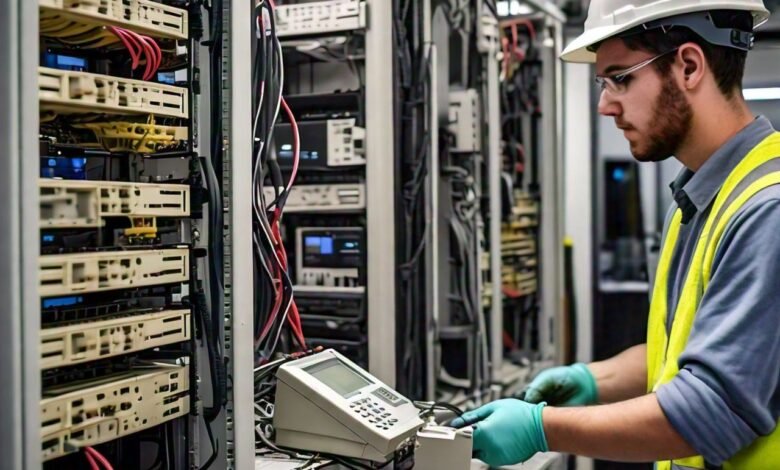The Transition From POTS Lines: What You Need To Know About Modern Telecommunication
Modern Alternatives to POTS Lines

- Overview of POTS Lines
- Why POTS Lines Are Being Phased Out
- Modern Alternatives to POTS Lines
- Benefits of Modern Telecommunication
- Impact on Businesses
- Choosing the Right Alternative
- Real-Life Examples of Transition
- Future of Telecommunication
Overview of POTS Lines
Plain Old Telephone Service (POTS), as the name suggests, refers to traditional analog telephone systems that have been the cornerstone of telecommunication for many years. These systems send voice signals through copper wires, providing reliable voice communication since the early 20th century. The simplicity and reliability of POTS made it a household and business staple. Despite its historical success, the inherent limitations of this technology have become increasingly evident. As digital communication technologies advance, the gap between the capabilities of POTS and modern alternatives continues to widen.
Why POTS Lines Are Being Phased Out
The transition from POTS lines to more advanced communication systems results from technological advancements that render analog systems increasingly obsolete. For instance, digital solutions offer better efficiency, reliability, and integration with various modern devices. However, with POTS lines going away, it’s essential to understand what this means for businesses and consumers who have relied on this service for decades. According to the Federal Communications Commission (FCC), transitioning from POTS to digital systems is a global shift towards more versatile and cost-effective telecommunication infrastructures.
Analog systems, despite their reliability, cannot match the functionality offered by digital communication technologies. Features like multi-party conferencing, video calls, and integration with business software are beyond the capabilities of traditional POTS lines. Consequently, businesses and consumers increasingly adopt digital alternatives to stay competitive and meet modern communication demands.
Modern Alternatives to POTS Lines
With the decline of POTS lines, several modern alternatives have emerged, offering more robust features and better integration with digital devices. VoIP (Voice over Internet Protocol), fiber-optic communications, and wireless technologies are the primary alternatives replacing POTS.
- VoIP (Voice over Internet Protocol): VoIP utilizes the capabilities of the Internet to transmit voice messages. It changes voice signals to digital data and sends them over IP networks. This technology offers cost savings by eliminating the need for separate voice and data networks and provides additional features such as voicemail to email, call forwarding, and virtual attendants.
- Fiber-Optic Communication: Fiber-optic technology uses thin glass or plastic fiber strands to transmit data through light signals. This technique enables fast data transfer, which is significant for companies with data-heavy tasks. Fiber-optic connections are known for their reliability, lower latency, and higher bandwidth than traditional copper wire systems.
- Wireless Technologies: Wireless communication technologies, including cellular networks and Wi-Fi, have become essential in modern telecommunication. These technologies provide mobility and flexibility, enabling users to connect virtually anywhere. They support many devices, from smartphones and tablets to IoT (Internet of Things), making them a versatile choice for individual and business use.
Benefits of Modern Telecommunication
The transition to modern telecommunication systems comes with numerous benefits, significantly enhancing the quality and efficiency of communication. These systems provide excellent reliability, advanced features, and scalability, which are crucial for supporting the dynamic needs of today’s users.
For instance, VoIP can help businesses reduce costs by eliminating the need for separate voice and data networks. Fiber-optic communication ensures high-speed data transfer, which is essential for companies that handle large volumes of data. Contemporary telecommunication systems provide improved bandwidth, reduced latency, and enhanced compatibility with digital devices and applications, resulting in a more efficient and seamless communication experience.
Impact on Businesses
The shift from POTS lines to modern telecommunication systems significantly impacts businesses. Enhanced productivity, streamlined operations, and support for remote work setups are just a few advantages of this transition. For a deeper understanding of the business impact, visit ZDNet.
Integrating telecommunication systems with other business software solutions, such as Customer Relationship Management (CRM), can improve customer service and operational efficiency. Modern communication tools facilitate better collaboration and coordination among team members regardless of physical location, thus supporting a more flexible and responsive business environment.
Choosing the Right Alternative
Reliability, cost, and specific business needs must be considered when selecting a modern telecommunication alternative. Consulting with IT professionals can help make an informed decision that aligns with the organization’s goals and requirements.
Businesses should consider factors like scale of operation, existing infrastructure, and future growth plans. A small business may find VoIP a perfect fit due to its cost-effectiveness and ease of deployment. In contrast, larger enterprises benefit more from dedicated fiber-optic networks that offer higher speeds and better reliability to support their extensive data transfer needs.
Real-Life Examples of Transition
Several companies have transitioned from POTS lines to modern telecommunication solutions, reaping significant benefits. For example, many startups leverage VoIP for its cost-effectiveness, while more giant corporations might install fiber-optic networks to ensure high-speed data transfer and reliable connectivity.
An example of this transition can be seen in tech-focused startups that rely on cloud-based communications to support their operations globally. These companies benefit from the flexibility and scalability offered by virtual communication systems. On the other hand, hospitals have adopted wireless technologies to ensure seamless communication and data transfer between various departments, improving patient care and operational efficiency.
Future of Telecommunication
The future of telecommunication promises even more advancements, such as integrating AI and machine learning into communication systems. These technologies will enhance the capabilities of telecommunication systems, offering more personalized and efficient communication solutions. We can expect even more innovative solutions to revolutionize communication as technology evolves.
Future innovations will likely enhance connectivity, improve reliability, and create a more seamless user experience. As telecommunication systems become more intelligent and integrated, they will play a critical role in supporting the digital transformation of businesses and society, paving the way for unprecedented efficiency and convenience. For more information visit ventsicon.com